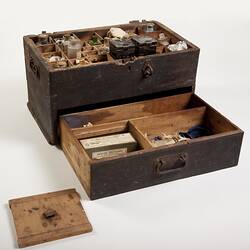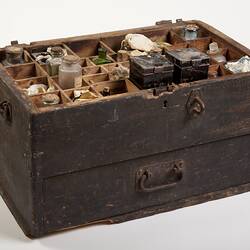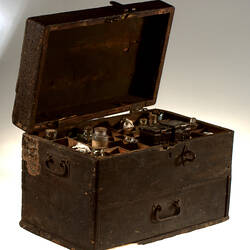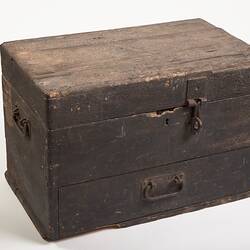Summary
Portable wooden chest or dispensary dating from mid to late 19th century. It is compartmentalised with top opening lid and lower front drawer for carrying a range of medicines and other items. It is claimed to have been used as a sea captain's medicine chest or ship's surgeon's medicine chest during the 1850s.
This chest is the type which would have been carried on sailing ships by the surgeon or captain during the mid to late 19th century. It relates to the provision of medical services during immigration and coastal voyages, and provides insight into medical practices of the 19th century.
During the mid to late 19th century, the general health of the patient often influenced their success in combating injury or illness as much as the ministrations of surgeon or other crew member, often the ship's cook. Pasteur's germ theory was only beginning to be more widely applied and infections were common, and could lead to death, even after a procedure as simple as having a tooth removed. The cramped, damp, and generally dirty conditions aboard ships did little to promote general good health. These conditions helped promote the spread of infectious diseases such as typhus and tuberculosis. Scurvy also remained common during the 19th century, as several of the measures introduced to combat it were ineffective, such as the daily provision of lime juice. For those sailing to tropical ports fevers such as yellow fever and malaria were common. Remedies provided for illness during the 19th century were also often dangerous, particularly if administered incorrectly, herbs, oils, spirits, poisons (lead and mercury), salts and drugs (including opium and cocaine) were among the items commonly administered to patients both on land and at sea.
This chest was part of the A.M.A. Medical Museum collection.
Physical Description
Heavy wooden box or chest with dove-tailed joints, top opening lid and single front opening drawer. Metal handles on each side and front drawer. Lid has built-in lock (broken) and off-centre external clasp for padlock, possibly added at a later date. Inside of lid lined with felt or similar fabric. Top section of chest contains a removable compartmentalised wooden tray containing various medicines or chemicals in corked glass bottles, as well as miscellaneous packages and tins.
More Information
-
Collecting Areas
Medicine & Health, Transport, Migration & Cultural Diversity
-
Acquisition Information
Donation from Australian Medical Association of Victoria (AMA) Medical Museum, circa 1978
-
Date Made
-
Date Used
-
Classification
-
Category
-
Discipline
-
Type of item
-
Overall Dimensions
61.5 cm (Length), 37.5 cm (Width), 41.5 cm (Height)
EXTERNAL DIMENSIONS WITH LID AND DRAWER CLOSED.
-
Exhibition Collection Management
640 mm (Length), 405 mm (Width), 730 mm (Height)
Height above is for item open- closed height = 410
-
Dimensions
670 mm (Length), 420 mm (Width), 410 mm (Height)
Measurement From Conservation.
-
Keywords
Healthcare & Medicine, Immigrant Shipping, Immigrant Voyages, Medical Apparatus & Instruments, Medicine Chests, Ship Accessories, Shipboard Travel, Water Transport, Tuberculosis










